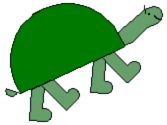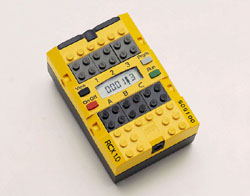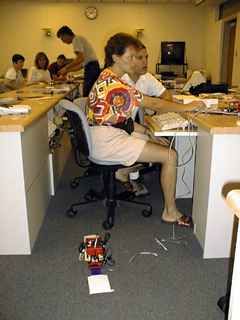Programmable Brick from LEGOA programmable brick known as the RCX™ is at the heart of the new LEGO® Mindstorms™ product line. Light sensors, touch sensors and motors, as well as standard LEGO bricks and elements may be attached to the RCX to create robotic devices. The RCX is similar to the programmable bricks developed at MIT as described in "Building and Learning with Programmable Bricks," Logo Update Vol. 3 No. 3, Spring 1995. Although inspired by the MIT research, the RCX was designed and built entirely by LEGO.
LEGO and LogoThe LEGO Mindstorms products are the latest in a series of LEGO robotics systems that began in 1986 with LEGO TC Logo™ and continued with the 1993 release of Control Lab™. Both of these products used Logo-based software developed by Logo Computer Systems, Inc. (LCSI). The software with LEGO TC Logo was a version of LCSI's popular LogoWriter™ with additional primitives added to read from sensors and to control motors and lights. Some LogoWriter features, such as color and multiple shapes for turtles were not included. There were versions for Apple II and MSDOS computers. In 1988 LogoWriter Robotics™ was released. It included all of the features of LogoWriter and of LEGO TC Logo in one program. People working with both environments no longer had to switch programs. The underlying software for Control Lab is fundamentally the same as MicroWorlds LCSI's current Logo product. It includes the parallelism of MicroWorlds, which is well suited to the needs of robotics programming. However, instead of the close match between LogoWriter, LEGO TC Logo, and LogoWriter Robotics, the user interface for Control Lab is very different from that of MicroWorlds. Some of the control and monitoring of robotic devices may be done through manipulation and viewing of screen objects, at least for simple projects.
The Programmable BrickResearchers at MIT have developed several generations of programmable bricks, including the Red Brick, and more recently, the more compact Cricket. Programmable bricks allow one to design and build smaller more mobile devices that are not encumbered by the need to maintain a connection with a desktop or laptop computer. A standard computer is used to create programs, which are then transmitted to the Brick via wires or an infrared link. Once the program is downloaded, the brick may be disconnected and functions on its own. The programmable bricks developed at MIT were programmed in Brick Logo, which is written in MicroWorlds. There is ongoing research focused on creating programming environments that include both visual and text-based programming. But at the present time the RCX products use iconic programming languages that do not include Logo or another text-based language. Cathy Fett of the LEGO Group told Logo Update that the software design was motivated by the goal of making programming easier for children and addressing areas of confusion they had with earlier text-based products.
What's Next?According to Fred Martin, a research scientist at the MIT Media Lab, the group has implemented prototype Logo software for the RCX, and is making arrangements to distribute it to interested members of the Logo community. LCSI president Michael Quinn says that the company is interested in developing Logo software for the RCX, but has no definite plans at this time. In principle it is possible to create a variety of programming environments for use with the RCX. LEGO is supporting such efforts with the recent release of a Software Developers Toolkit, and an unofficial LEGO Mindstorms Internals page has technical information for developers. LEGO Mindstorms products are available through retail outlets and from Pitsco, Inc. (800-362-4308). Visit the LEGO Mindstorms information page and Fred Martin's Programmable Brick information page.
|
|||||||||||
|
|
|
||||




